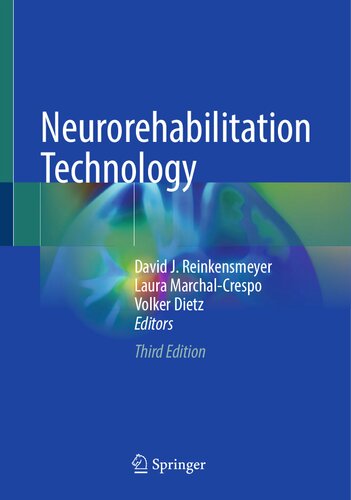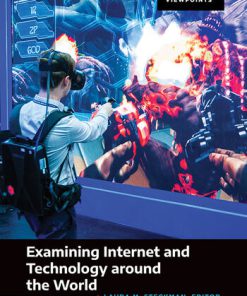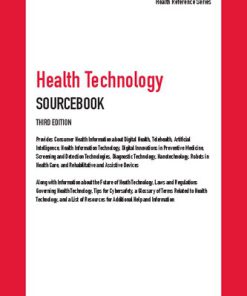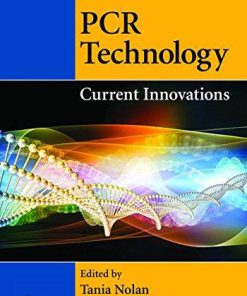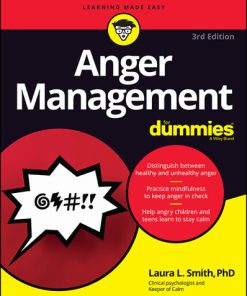Neurorehabilitation Technology 3rd Edition by David J Reinkensmeyer, Laura Marchal Crespo, Volker Dietz 3031089944 9783031089947
$50.00 Original price was: $50.00.$25.00Current price is: $25.00.
Neurorehabilitation Technology 3rd Edition David J Reinkensmeyer Laura Marchal Crespo Volker Dietz – Ebook PDF Instant Download/Delivery ISBN: 3031089944, 9783031089947
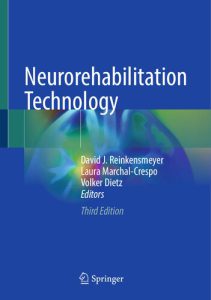
Product details:
- ISBN 10: 3031089944
- ISBN 13: 9783031089947
- Author: David J. Reinkensmeyer, Laura Marchal-Crespo, Volker Dietz
This revised, updated, and substantially expanded third edition provides an accessible, practical overview of major areas of research, technical development and clinical application in the field of neurorehabilitation movement therapy. The initial section provides the basic framework and a rationale for technology application in movement therapy by summarizing recent findings in neuroplasticity and motor learning. The following section provides a detailed overview of the movement physiology of various neurologic conditions, illustrating how this knowledge has been used to design various neurorehabilitation technologies. The third section then explains the principles of human-machine interaction for movement rehabilitation. The fourth section provides an overview of assessment technology and predictive modeling in neurorehabilitation. The fifth section provides a survey of technological approaches to neurorehabilitation, including spinal cord stimulation, functional electrical stimulation, virtual reality, wearable sensing, brain computer interfaces, mobile technologies, and telerehabilitation. The final two sections examine in greater detail the ongoing revolution in robotic therapy for upper extremity movement and walking, respectively. The promises and limitations of these technologies in neurorehabilitation are discussed, including an Epilogue which debates the impact and utility of robotics for neurorehabilitation. Throughout the book the chapters provide detailed practical information on state-of-the-art clinical applications of these devices following stroke, spinal cord injury, and other neurologic disorders and future developments in the field. The text is illustrated throughout with photographs and schematic diagrams which serve to clarify the information for the reader.
Table contents:
Part I. Basic Framework: Motor Recovery, Learning, and Neural Impairment
1. Learning in the Damaged Brain/Spinal Cord: Neuroplasticity
2. Movement Neuroscience Foundations of Neurorehabilitation
3. Recovery of Sensorimotor Functions After Stroke and SCI: Neurophysiological Basis of Rehabilitation Technology
Part II. From Movement Physiology to Technology Application
4. Use of Technology in the Assessment and Rehabilitation of the Upper Limb After Cervical Spinal Cord Injury
5. Implementation of Impairment-Based Neurorehabilitation Devices and Technologies Following Brain Injury
6. The Hand After Stroke and SCI: Restoration of Function with Technology
7. Neural Coordination of Cooperative Hand Movements: Implications for Rehabilitation Technology
8. Robotic Gait Training in Specific Neurological Conditions: Rationale and Application
Part III. Principles for Interactive Rehabilitation Technology
9. Designing User-Centered Technologies for Rehabilitation Challenge that Optimize Walking and Balance Performance
10. Psychophysiological Integration of Humans and Machines for Rehabilitation
11. Sensory-Motor Interactions and the Manipulation of Movement Error
12. The Role of Haptic Interactions with Robots for Promoting Motor Learning
13. Implementation of Robots into Rehabilitation Programs: Meeting the Requirements and Expectations of Professional and End Users
14. Clinical Application of Rehabilitation Therapy Technologies to Children with CNS Damage
Part IV. Assessment Technology and Predictive Modeling
15. Robotic Technologies and Digital Health Metrics for Assessing Sensorimotor Disability
16. Computational Neurorehabilitation
17. Precision Rehabilitation: Can Neurorehabilitation Technology Help Make It a Realistic Target?
Part V. General Technological Approaches in Neurorehabilitation
18. Spinal Cord Stimulation to Enable Leg Motor Control and Walking in People with Spinal Cord Injury
19. Functional Electrical Stimulation Therapy: Mechanisms for Recovery of Function Following Spinal Cord Injury and Stroke
20. Basis and Clinical Evidence of Virtual Reality-Based Rehabilitation of Sensorimotor Impairments After Stroke
21. Wearable Sensors for Stroke Rehabilitation
22. BCI-Based Neuroprostheses and Physiotherapies for Stroke Motor Rehabilitation
23. Passive Devices for Upper Limb Training
24. Mobile Technology for Cognitive Rehabilitation
25. Telerehabilitation Technology
Part VI. Robotic Technologies for Neurorehabilitation: Upper Extremity
26. Forging Mens et Manus: The MIT Experience in Upper Extremity Robotic Therapy
27. Three-Dimensional Multi-Degree-of-Freedom Arm Therapy Robot (ARMin)
28. Upper-Extremity Movement Training with Mechanically Assistive Devices
Part VII. Robotic Technologies for Neurorehabilitation: Gait and Balance
29. Technology of the Robotic Gait Orthosis Lokomat
30. Using Robotic Exoskeletons for Overground Locomotor Training
31. Beyond Human or Robot Administered Treadmill Training
32. A Flexible Cable-Driven Robotic System: Design and Its Clinical Application for Improving Walking Function in Adults with Stroke, SCI, and Children with CP
33. Body Weight Support Devices for Overground Gait and Balance Training
34. Epilogue: Robots for Neurorehabilitation—The Debate
People also search:
neurorehabilitation technology 3rd edition
neurorehabilitation research
neurotech r3
neurorehabilitation therapy
neurorehabilitation technology
You may also like…
Politics & Philosophy - Government & Politics
Examining Internet and Technology around the World Global Viewpoints Laura M. Steckman
Romance - Other Romance Categories
Education Studies & Teaching - Educational Theory
Engineering - Chemical Engineering
Biology and other natural sciences - Microbiology
PCR Technology 3rd Edition by Tania Nolan 9781439848135 1439848130
Relationships & Lifestyle - Relationships
Computers - Artificial Intelligence (AI)

